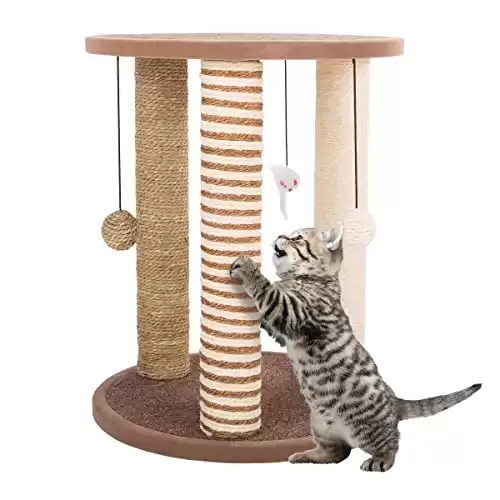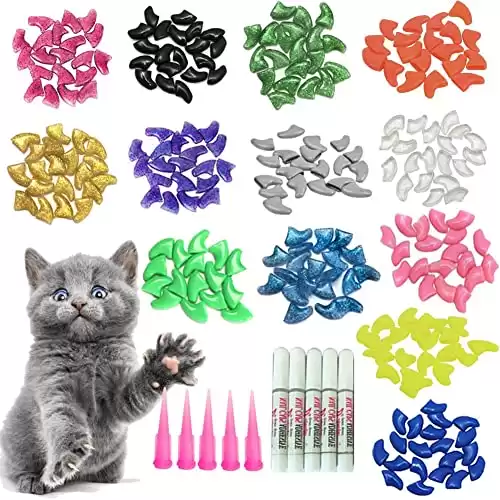No matter how well-behaved your cat is, there’s always the chance it may have the urge to sharpen its claws on your furniture. This is a frustration that many cat owners deal with. Fortunately, there are a few ways you can cat-proof your home and protect your furniture. Read on to learn more.
Why Do Cats Scratch Things?
It is a part of cats’ natural instincts to scratch things. For them, it is a way to mark their territory, release tension, or stretch. Although, the main benefit cats get from scratching things is keeping their nails trimmed, which is important. Obviously, we don’t want our feline friends to scratch up our couches as a way to keep their nails trimmed. So one of the best ways to help reduce destructive behavior is to help your cat by trimming its nails for them. It’s simple and easy to do this at home as long as you have the appropriate tools. Be sure that you have a good quality nail trimmer for your cat so that you can clip their nails safely.
- Stainless steel design is durable yet lightweight
- Sharp edge ensures quick, precise clip every time
- Comfortable grip
What Can I Do to Stop My Cat From Scratching?
There is no safe way to stop your cat completely from the act of scratching. However, there are some ways that you can discourage scratching on certain areas or items within your home. Let’s go over a few of the ways you can do this:
Give Your Cat an Alternative
One of the simplest things you can do to stop your cat from scratching up your furniture is to give them an alternative that is okay for them to scratch. This would mean giving your cat a scratching post that is meant for them to scratch. Try setting up a scratching post near one of the places that your cat was scratching before in order to discourage them from scratching the furniture and go for the scratch post instead.
If one of the reasons why your cat is scratching is to mark its territory, then it’s important to make sure that you set the scratching posts near areas where you have seen your cat scratching before. If your cat likes to scratch on or near your bed, place a scratching post there to redirect them to scratch the post instead. You can try placing more than one around your house to cover all the areas that your cat generally likes to scratch.
When you see your cat using the scratch posts instead of scratching your furniture, be sure to reward your cat with positive reinforcement for their correct behavior. You can do this by giving them a quick rub and encouraging words and or giving them a treat. The cat will then begin to associate scratching the cat post as a good, rewarding thing to do.
If at first, your cat doesn’t seem to be drawn to using the scratching post, you may want to try using ones made from different materials, as some textures might be more appealing to your cat than others.
- Features 3 posts
- Comes with hanging toys
- Sturdy design
- Made from durable materials
Utilize Citrus Scents
Another way you can deter your cat from scratching your home’s furniture is by applying a citrus scent. These scents may smell pleasant to us, but cats tend to despise them. This means they can make a nice natural way to keep your cats away from your furniture. You can use a citrus-scented air freshener or you can make a DIY version yourself by combining water and a few drops of orange or lemon scented essential oil into a spray bottle. You can then use this mixture to spray the areas that you know your cat likes to scratch. Once it smells the citrus scent you should notice that it won’t scratch the furniture as the smell should deter it from doing so.
- 100% pure lemon essential oil
- Smells fresh and amazing
- Certified USDA — registered on the USDA Organic Database
- Healing Solutions offers a purity guarantee — every oil they sell has been GCMS tested and analyzed for purity
Use Apple Cider Vinegar
If you don’t have essential oils, you can also use apple cider vinegar. You can combine equal parts water and apple cider vinegar into a spray bottle and then spray the areas that your cat usually scratches. If you want to be safe, you can first dab a tiny amount to be sure that the mixture will not harm your fabric before spraying.
- Certified organic
- This raw apple cider vinegar is unfiltered, unheated, and unpasteurized
- 5% acidity
- Kosher
- Gluten-free and non-GMO certified
Try Using Sticky Tape
If you don’t want to spray oils or use apple cider vinegar spray on your furniture, you can try using double-sided tape. This is a simple fix for getting your cats to stop scratching at your furniture as well since cats hate things that are sticky. If you apply some of the double-sided tape to the parts of your furniture that your cat tends to scratch, the cat may attempt to scratch and then realize its paws stick to the tape. After this, the cat will be unlikely to continue trying to sharpen its nails in that spot. Once your cat no longer attempts to scratch its nails there, you can remove the tape.
You can also do this in conjunction with placing scratch posts nearby so that as your cat learns the correct places to scratch, it can be discouraged from scratching in the old places (your furniture). This helps your cat learn the new positive behavior while discouraging the old bad behavior.
- Made of acrylic-glue material
- Super sticky and strong
- Durable and removable
- Leaves no residue
Should I Declaw My Cat?
If you feel like you’ve tried it all and are wondering if the solution would be to simply have your cat declawed, the answer would be no. Many experts agree that having a cat declawed should not be an option. Unfortunately, many cat owners believe that having their cat declawed will be a simple, easy solution to preventing their cat from scratching their furniture and destroying other things around the house. While this will prevent your cat from scratching things, it is a painful and as many consider, a cruel thing to do. There are also many unwanted side effects that come along with having a cat declawed, many of which were probably not issues before.
Declawing a cat can have many long-lasting physical effects on your cat. In some cases, having a cat declawed can result in your cat becoming unwilling to use its litter box and preferring to do its business in other places throughout your home. This is because, without its claws, it becomes painful for your cat to dig in the litter box. Because of this, the cat will likely begin to go outside of the litter box in various places throughout your home. This could mean even more damage to your couch, besides the scratched fabric.
The process of having your cat declawed requires the amputation of the last bone in the cat’s toes. This is extremely painful for your cat and is one of the reasons why having a cat declawed is banned in some countries.
As mentioned before, one of the best things you can do to help reduce scratching behavior is to keep your cat’s nails trimmed regularly. Even if your cat still attempts to scratch furniture, having its nails trimmed can reduce the damage it is able to do to your furniture since its nails wont be as sharp.
Cat Nail Covers
If all else fails, you can also try using cat nail covers. These should only be used as a temporary solution as your cat learns the correct behaviors, in order for your to keep your furniture protected as it does. These can also be irritating to your cat to use, so they are not recommended as a permanent solution. However, they can help protect your furniture from being damaged as you train your cat not to scratch it.
- Crafted from high-quality vinyl resin
- Soft and comfortable for your cat to wear
- Nail covers protect your furniture and other surfaces
- Follow manufacturer's directions to apply
- Package includes 100 pieces in 10 different colors , glue, and a 5-piece applicator
The best way to prevent your cat from scratching your furniture is to train them from an early age as well as trim their nails early on. This allows them to get used to the trimming and not react so strongly against it. Most cats are around 8 weeks old when they first begin scratching. This is the time that you’d want to train your kitten to use a scratch post to scratch so that it doesn’t pick up the habit of scratching your furniture.
Declawing should never be used as a solution to scratching, as it can introduce an entirely new set of behavior issues that were not present before that could be much worse than scratching furniture. Many people mistakenly believe that having a cat declawed is simply removing the cat’s nails, however, this is far from the case.
Declawing your cat not only involves removing its nails but the amputation of the last bone in each of its toes as well to make sure that the nails will not grow back. This would be the same thing as having your fingers cut off at the last knuckle. This causes a tremendous amount of pain for the cat, and as mentioned can cause other issues to arise like not using the litter box and using your couch or carpet instead.
Up Next
- The Best Cat Litter for Picky Cats (and Kittens!)
- All of Your Cat’s Crazy Behaviors, Explained
- The Best Cat Trees in 2022—for Individual and Multiple Cats
The photo featured at the top of this post is © iStock.com/Magui-rfajardo
Sources
- Pet MD, Available here: https://www.petmd.com/cat/slideshows/how-cat-proof-your-couch
- Humane Society, Available here: https://www.humanesociety.org/resources/declawing-cats-far-worse-manicure
- Declawing, Available here: https://www.declawing.com/countries-that-outlaw-declawing
Thank you for reading! Have some feedback for us? Contact the AZ Animals editorial team.












